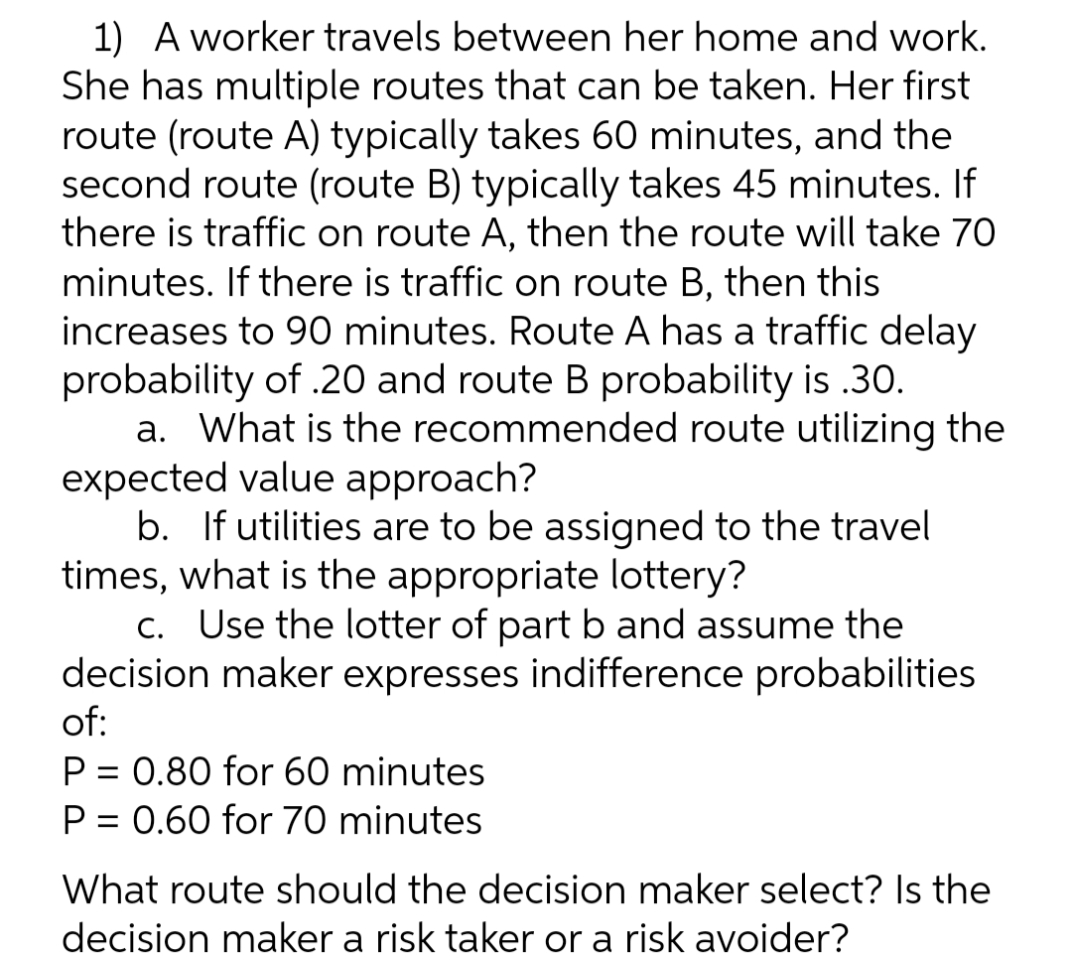1) A worker travels between her home and work. She has multiple routes that can be taken. Her first route (route A) typically takes 60 minutes, and the second route (route B) typically takes 45 minutes. If there is traffic on route A, then the route will take 70 minutes. If there is traffic on route B, then this increases to 90 minutes. Route A has a traffic delay probability of .20 and route B probability is .30. a. What is the recommended route utilizing the expected value approach? b. If utilities are to be assigned to the travel times, what is the appropriate lottery? C. Use the lotter of part b and assume the decision maker expresses indifference probabilities of: P = 0.80 for 60 minutes P = 0.60 for 70 minutes %3D What route should the decision maker select? Is the decision maker a risk taker or a risk avoider?
1) A worker travels between her home and work. She has multiple routes that can be taken. Her first route (route A) typically takes 60 minutes, and the second route (route B) typically takes 45 minutes. If there is traffic on route A, then the route will take 70 minutes. If there is traffic on route B, then this increases to 90 minutes. Route A has a traffic delay probability of .20 and route B probability is .30. a. What is the recommended route utilizing the expected value approach? b. If utilities are to be assigned to the travel times, what is the appropriate lottery? C. Use the lotter of part b and assume the decision maker expresses indifference probabilities of: P = 0.80 for 60 minutes P = 0.60 for 70 minutes %3D What route should the decision maker select? Is the decision maker a risk taker or a risk avoider?
Practical Management Science
6th Edition
ISBN:9781337406659
Author:WINSTON, Wayne L.
Publisher:WINSTON, Wayne L.
Chapter12: Queueing Models
Section12.5: Analytic Steady-state Queueing Models
Problem 26P
Related questions
Question
answer in 30 minutes.

Transcribed Image Text:1) A worker travels between her home and work.
She has multiple routes that can be taken. Her first
route (route A) typically takes 60 minutes, and the
second route (route B) typically takes 45 minutes. If
there is traffic on route A, then the route will take 70
minutes. If there is traffic on route B, then this
increases to 90 minutes. Route A has a traffic delay
probability of .20 and route B probability is .30.
a. What is the recommended route utilizing the
expected value approach?
b. If utilities are to be assigned to the travel
times, what is the appropriate lottery?
C. Use the lotter of part b and assume the
decision maker expresses indifference probabilities
of:
P = 0.80 for 60 minutes
P = 0.60 for 70 minutes
%3D
%3D
What route should the decision maker select? Is the
decision maker a risk taker or a risk avoider?
Expert Solution
This question has been solved!
Explore an expertly crafted, step-by-step solution for a thorough understanding of key concepts.
Step by step
Solved in 2 steps

Recommended textbooks for you

Practical Management Science
Operations Management
ISBN:
9781337406659
Author:
WINSTON, Wayne L.
Publisher:
Cengage,

Practical Management Science
Operations Management
ISBN:
9781337406659
Author:
WINSTON, Wayne L.
Publisher:
Cengage,